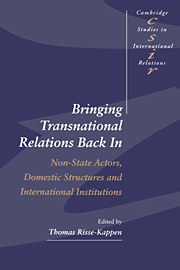 Bringing Transnational Relations Back In
Bringing Transnational Relations Back In Book contents
- Frontmatter
- Contents
- List of tables
- List of contributors
- Preface
- List of abbreviations
- Setting the agenda
- Case studies
- 2 Transnational relations and the development of European economic and monetary union
- 3 “Bullying,” “buying,” and “binding”: US–Japanese transnational relations and domestic structures
- 4 MNCs and developmentalism: domestic structure as an explanation for East Asian dynamism
- 5 Transnational relations, domestic structures, and security policy in the USSR and Russia
- 6 Mechanics of change: social movements, transnational coalitions, and the transformation processes in Eastern Europe
- 7 Ivory, conservation, and environmental transnational coalitions
- Conclusions: So what?
- Index
- CAMBRIDGE STUDIES IN INTERNATIONAL RELATIONS
2 - Transnational relations and the development of European economic and monetary union
Published online by Cambridge University Press: 02 December 2009
- Frontmatter
- Contents
- List of tables
- List of contributors
- Preface
- List of abbreviations
- Setting the agenda
- Case studies
- 2 Transnational relations and the development of European economic and monetary union
- 3 “Bullying,” “buying,” and “binding”: US–Japanese transnational relations and domestic structures
- 4 MNCs and developmentalism: domestic structure as an explanation for East Asian dynamism
- 5 Transnational relations, domestic structures, and security policy in the USSR and Russia
- 6 Mechanics of change: social movements, transnational coalitions, and the transformation processes in Eastern Europe
- 7 Ivory, conservation, and environmental transnational coalitions
- Conclusions: So what?
- Index
- CAMBRIDGE STUDIES IN INTERNATIONAL RELATIONS
Summary
On February 7, 1992, in the Dutch city of Maastricht, the foreign and finance ministers of the twelve member states of the European Community signed the Treaty on European Union. The most ambitious effort ever undertaken in the Community to create new supranational institutions, and to transfer authority from the member states to those institutions, the Treaty committed the member states, among other things, to moving to full Economic and Monetary Union (EMU) by 1999 at the latest. By that date, if not before, some, if not all, of the members will move to the third and final stage of EMU, and the exchange rates between their currencies will be irrevocably locked, a single currency instituted, and a single central bank created that is charged with conducting monetary policy among the participating states.
Those who study policymaking and politics within the European Community (EC) – since November 1993, Union – typically conceive of them as the product, in varying degrees, of two forces – intergovernmentalism and supranationalism. Some accord primacy to the member states and view the policy choices of the Community as manifestations of the continuing domination of the states, acting to achieve their national interests through such institutions as the Council of Ministers and the European Council. From that perspective, Community politics and policy-making largely consist of the formation of coalitions and alliances among states, and the attainment and defeat of the interests and preferences of the states. In contrast, others accord primacy to the supranational institutions and actors within the Community, such as the Commission and the Court of Justice, and perceive its politics and policymaking as manifestations of the influence of those institutions and actors.
- Type
- Chapter
- Information
- Bringing Transnational Relations Back InNon-State Actors, Domestic Structures and International Institutions, pp. 37 - 78Publisher: Cambridge University PressPrint publication year: 1995
- 24
- Cited by
